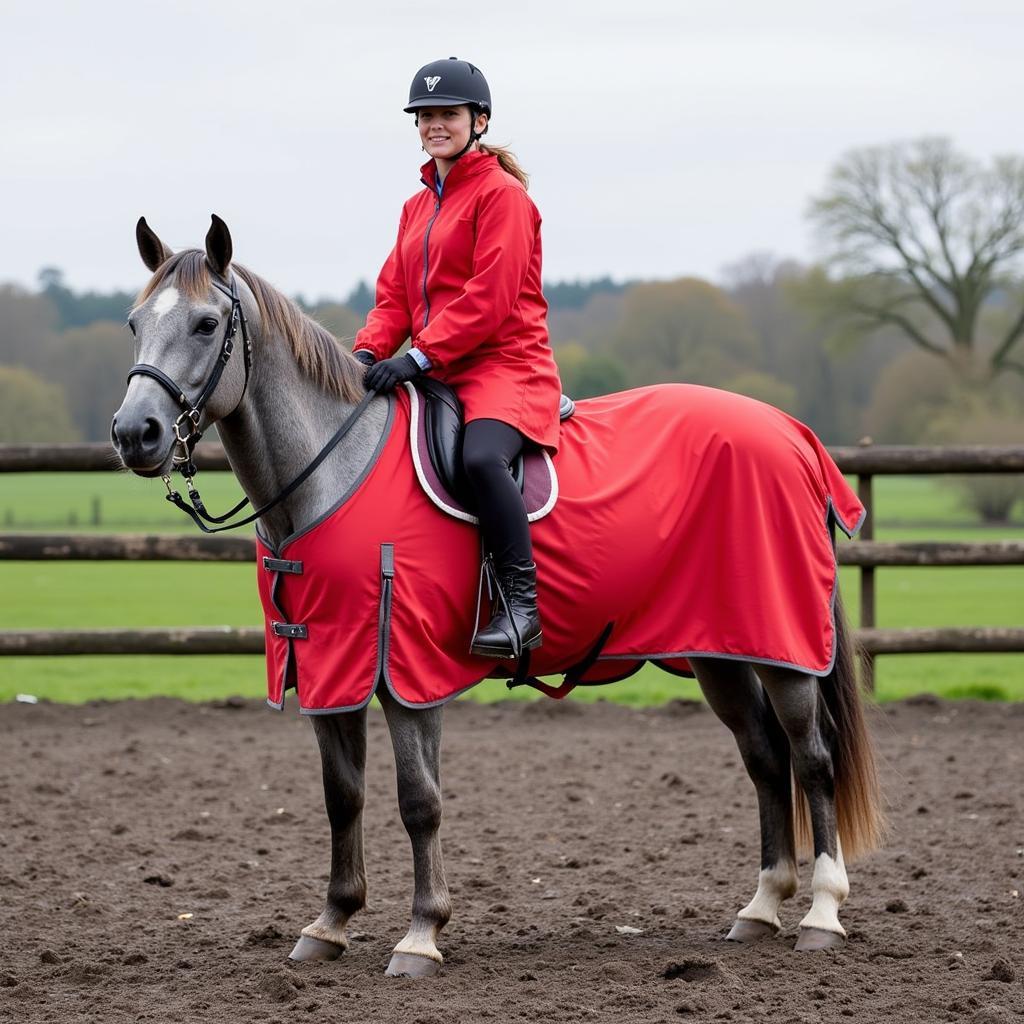Horse Ponchos have become increasingly popular in recent years, and for good reason! These versatile garments offer a range of benefits for horses, from providing warmth and protection from the elements to adding a touch of style. Whether you’re a seasoned equestrian or a new horse owner, understanding the why and how of using horse ponchos can help you keep your equine companion comfortable and looking their best.
Why Choose a Horse Poncho?
Horse ponchos offer several advantages over traditional horse blankets:
- Ease of Use: Ponchos are incredibly easy to put on and take off, making them a convenient option for busy horse owners. Unlike blankets with multiple buckles and straps, most ponchos simply slip over the horse’s head and rest comfortably on their back.
- Versatility: Horse ponchos are available in a range of materials, weights, and styles, making them suitable for various weather conditions and purposes.
- Breathability: Many ponchos are designed with breathable fabrics that allow for proper air circulation, preventing your horse from overheating, especially during warmer weather or when exercising.
- Protection: A good poncho can shield your horse from rain, wind, and cold, keeping them warm and dry. Some ponchos even offer UV protection, which is essential for horses with sensitive skin.
- Style: Beyond their practical benefits, horse ponchos can add a touch of personality and flair to your horse’s wardrobe.
Types of Horse Ponchos
- Waterproof Ponchos: Ideal for rainy days, these ponchos are typically made from waterproof and breathable fabrics like nylon or polyester. They effectively keep your horse dry and comfortable during wet weather rides or turnout.
- Fleece Ponchos: Perfect for cooler days or as an extra layer under a winter blanket, fleece ponchos provide warmth without being bulky. They are also great for use after a workout to help wick away moisture and prevent chills.
- Cooler Ponchos: Designed to help cool down a hot horse after exercise, cooler ponchos are made from lightweight, breathable materials that allow for optimal airflow.
- Fly Ponchos: These ponchos provide a barrier against pesky insects, offering relief from flies and other biting bugs during the warmer months.
Choosing the Right Poncho for Your Horse
Consider these factors when selecting a horse poncho:
- Size and Fit: A well-fitting poncho should cover the horse’s back and sides adequately without restricting movement or rubbing. Measure your horse carefully before purchasing.
- Material: Choose a material that suits your intended use and climate. Waterproof fabrics are essential for wet weather, while breathable fabrics are best for warmer temperatures.
- Features: Look for features like adjustable straps, tail flaps, and belly bands for a secure and comfortable fit. Reflective strips can be helpful for visibility during low-light conditions.
- Durability: Invest in a poncho made from high-quality materials that can withstand regular use and washing.
Putting on a Horse Poncho
While ponchos are generally easy to put on, it’s important to approach your horse calmly and confidently:
- Prepare your horse: Make sure your horse is calm and secure. It’s helpful to have a halter and lead rope for control.
- Drape the poncho: Gently drape the poncho over the horse’s back, ensuring the neckline is centered.
- Secure the poncho: If the poncho has straps, fasten them securely but not too tightly. Make sure the straps lie flat and don’t rub.
 Horse and Rider in Matching Ponchos
Horse and Rider in Matching Ponchos
Caring for Your Horse’s Poncho
- Regular cleaning: Dirt and sweat can accumulate on the poncho, so it’s important to clean it regularly according to the manufacturer’s instructions.
- Proper storage: Store the poncho in a clean, dry place when not in use to prevent mildew and damage.
When to Consult a Professional
While horse ponchos are generally safe and easy to use, there are times when it’s best to consult with your veterinarian or a qualified equine professional:
- If your horse has any skin conditions or sensitivities to ensure the poncho material won’t cause irritation.
- If you are unsure about the proper fit or use of a poncho to prevent potential discomfort or injury to your horse.
By following these guidelines and choosing the right poncho for your horse’s needs, you can help ensure they stay comfortable, protected, and stylish in any weather.
Frequently Asked Questions About Horse Ponchos
1. Can I leave a poncho on my horse overnight?
It’s generally not recommended to leave a poncho on your horse overnight, especially if it’s waterproof. Waterproof materials can trap moisture and heat, leading to discomfort and potential skin problems.
2. What size poncho does my horse need?
Horse ponchos typically come in sizes that correspond to standard blanket sizes. Measure your horse from the center of their chest to the point of their buttock to determine the appropriate size.
3. Are horse ponchos safe for use during riding?
Yes, many horse ponchos are designed for use during riding. However, it’s essential to choose a poncho that fits well and doesn’t restrict the horse’s movement. Always check the manufacturer’s instructions for specific recommendations.
4. How do I wash a horse poncho?
Most horse ponchos can be machine washed on a gentle cycle with cold water and a mild detergent. Avoid using bleach or fabric softeners. Air dry the poncho thoroughly before storing.
5. Can I use a horse poncho on other animals?
While horse ponchos are designed for horses, they may be suitable for other large animals with similar body shapes, such as donkeys or mules. However, ensure the poncho fits correctly and doesn’t pose any hazards.
Need help finding the perfect horse poncho for your equine friend? Contact us! Our team at Justus Horses USA is happy to assist you. Call us at 0772127271, email us at [email protected], or visit our location at QGM2+WX2, Vị Trung, Vị Thuỷ, Hậu Giang, Việt Nam. We offer 24/7 customer support.